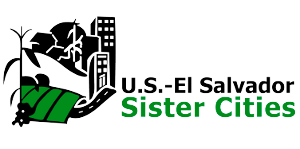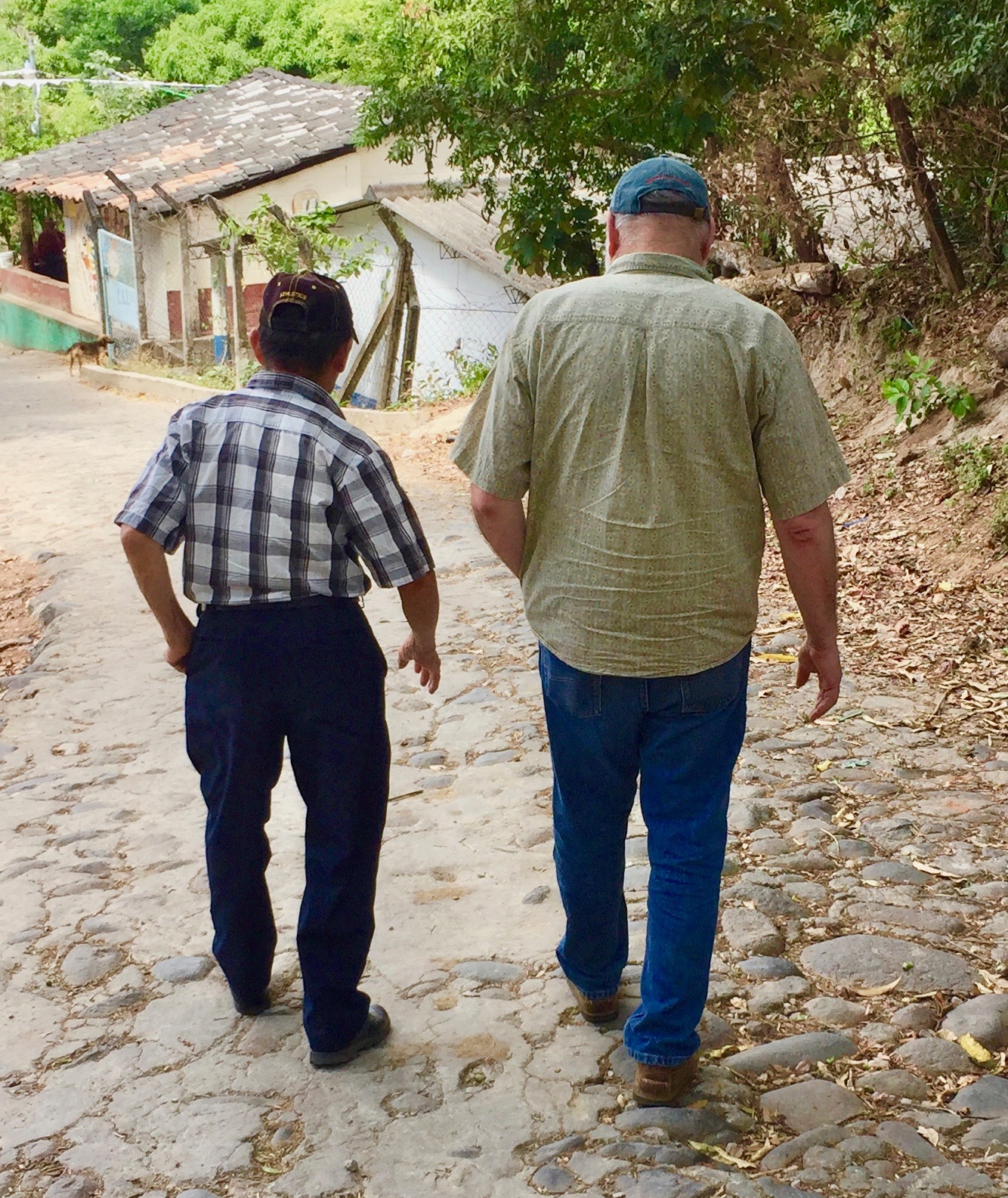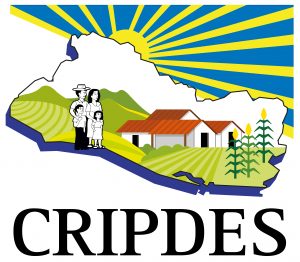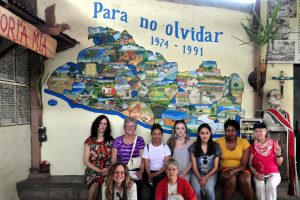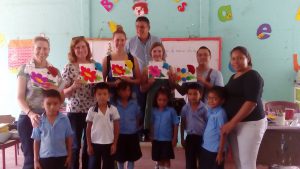Community Development Projects, Delegations
“My Introduction to the World”: Delegate Describes Her Experience
Written by Cassie Alley
Member of the Bangor-Carasque Sister Cities Committee
When I was 17 years old, I went through an experience that changed me profoundly. On October 28th, 2006, I became a citizen of the world, and began to assume the responsibilities that come with being a member of a world community. For the previous year, I had been a part of an organization in Bangor, Maine, called Peace through Inter-American Community Action (PICA) through their youth group, Youth Adelantando. PICA had come into existence in the 1980s, during the time of the Salvadoran Civil War. PICA began as an organization sistered with the community of Carasque in the region of Chalatenango, El Salvador. This sister relationship is made possible through the organization called U.S.-El Salvador Sister Cities, which is comprised of 17 community organizations throughout the United States that have sister communities in El Salvador. These sistering relationships are based on ideals of solidarity and support rather than “helping” and “charity.” Our Salvadoran sisters communicate with us about the problems they are facing on social and civil fronts in their country. Our job in the relationship is to spread their stories to our communities in the United States and urge our government not to intervene in El Salvador’s political scene. PICA sends at least one delegation of various community members every year to our sister community of Carasque. On October 28th, 2006, our delegation of five adults and six area youth disembarked on our life-changing journey to El Salvador where we would learn first hand about the people’s suffering, endurance, and hope throughout the last few decades and into the present. To recount the experiences of those nine days in El Salvador would take an entire book. I feel as if I could never relay the enormity of the experience as a whole. At the same time, I could never have enough time to tell about all the little experiences that made up that whole. I think what I can say, however, is how those days changed my sense of civil engagement and participation in the world. In this country, we often only hear about this country. Most citizens of the United States never get a true picture of a place outside our borders. The purpose of our delegation was to learn. This is my diary from that nine-day trip.
OCTOBER 28, 2006 We arrived in El Salvador today. We are staying in Pueblos a Pueblos guest house in San Salvador. The trip was long, but I love all the people in our delegation group. The air here smells like my Aunt Lynn’s greenhouse, like damp and fragrant soil, and the hills are beautiful. It is hot and humid, and I’m tired from the journey.
OCTOBER 29, 2006
Today we took a trip to the town of Cinquera to hear a local historian and community elder, Don Pablo, tell us the story of El Salvador’s Civil War: Social and civil unrest throughout the 1970s and ‘80s had led up to the breakout of civil war that lasted from the early ‘80s until 1992. By the late ‘70s and ‘80s, the people of El Salvador had formed guerrilla groups to combat the extreme right, oppressive military “death squads” that were being dispatched by the Salvadoran government to squash their social movement. The government spread propaganda telling people that their movement was communism and that communism was evil and anti-Christian. In Cinquera in the 1970s, a new priest was brought into the town. He helped the people of Cinquera understand the Bible in light of their own lives and understand that, according to the Bible, the oppression they were experiencing at the hands of the government was unjust. These teachings were a part of a movement within the catholic church and rural communities of El Salvador called “Liberation Theology,” and communities that took part in that movement were called “Christian-Based Communities.” With the help of these teachings, Cinquera became a real community, helping each other with sickness and hunger. All of the community members became each other’s safety net in the times of oppression through which they were fighting. When the military found out about Liberation Theology, they began to spread themselves throughout the region, which had many towns just like Cinquera beginning to come together against government oppression. This was a time when the government, with the assistance of the death squads, began to capture people and torture them for following Liberation Theology. In 1979, a bishop from San Vicente was sent to investigate claims of communism in the town of Cinquera. The bishop and members of ORDEN, a right-wing militaristic organization connected with the Salvadoran government of the time, called the town to meet in the church. The bishop and the ORDEN members excommunicated the priest and the people of Cinquera. One 17-year-old girl spoke up and said that the bishop from San Vicente spoke as if he were a rich oppressor, not a shepherd of the people. The members of ORDEN, by order of the priest, took the girl away into the woods. They raped her for three days and three nights. They cut off her ears, her breasts, her nose, her tongue, and gauged out her eyes. They then killed her with two stakes driven up through her body. This was the first murder of a member of a Christian-Based Community. The people began to flee their communities after witnessing such atrocities, which tore apart towns that had come together so effectively. Guerrilla groups began to form to fight against the government death squads and ORDEN. The United States sent the Salvadoran government billions of dollars in assistance to form these death squads and build up the army that was shamelessly oppressing, violating, and killing innocent townspeople all over El Salvador.
LATER
The people of this country have been through so much pain and violence, yet they bear it so well and understand the importance of keeping the memories alive. After listening to Don Pablo’s story, we went for a hike in the forest just outside the village. I was in a jungle! It was beautiful. The nature here is incredible. Throughout the walk I just had to stop and appreciate the sounds, smells and sights of the moment. After we had climbed up the mountain, walking between beautiful enormous green trees with bright colored insects and birds all around, we stayed for a little while at the wooden lookout post that had been built at the summit. The view was absolutely incredible–lush, green, rolling mountains dotted with the bluest lakes, all spread over with a magnificent azure sky. When we walked down the mountain, we made a pit stop at a little waterfall. As I laid back in the water, getting the nape of my neck wet and floating on my back, I felt I must be in heaven. I feel so connected. Connected to this Earth and the trees. Connected to the people in my delegation. Connected to the people in this country. Connected within myself to create this sort of inner completeness and peace. It’s baffling to me that so much pain could have happened in such a breathtaking place. The atmosphere of this country is so peaceful–how could horrors like those they’ve lived through exist here? Don Pablo cried. Five of his own children were killed in the civil war, yet he has such strength of body and mind and spirit, even after all of that. I have lived in such peace. Today was amazing. I feel like I’m doing something important.
OCTOBER 30, 2006
Today we went to a meeting with the Vice President of CRIPDES and a man from MPR-12, two grassroots organizations that are at the forefront of the Salvadoran social movement. It’s interesting that the same things are happening all over the world: People just can’t do what they’ve always done anymore. It’s either a huge corporate farm or no farm at all. The rich just get richer and everyone else just gets poorer. 1/5 of El Salvador’s population is in “extreme poverty.” This is largely due to the free-trade agreements that have devastated El Salvador‘s economy.. After the meeting, we embarked on our four-hour trip to Carasque. When we finally got to the village, every person was out to meet us! They helped us bring our luggage and supplies into the guest house and hung around outside with us before we went to dinner. A woman named Julia cooked our meal for us in her house of cement-block walls and dirt floors. After dinner, we headed up to the dance that the community had organized to welcome us to their village.
OCTOBER 31, 2006
I woke up this morning cold, but beautifully rested.
This morning is gorgeous. I’m sitting here between the four walls of our guest house, which consists of a cement floor, painted cement-block walls, and a corrugated tin roof. The windows are just holes in the walls with iron bars in them. The walls of the guest house are covered in posters and names. One hand-made sign says: “En memoria a nuestros Martires, iNuestros martires viven en nuestro pueblo!” (In memory of our martyrs. Our martyrs live in our people!) Another says: “El Salvador lucha por la verdadera indepencia” (El Salvador fights for true independence.)
The sun is shining and I can hear a few people going about their work outside. I hear the stream tumbling down the hill, the bugs chirping in the forest, and roosters crowing, and I can smell the fresh, warm morning air in the mountains.
Every now and then some cows wander by in the street. Sometimes a man is with them.
NOVEMBER 1, 2006
I’m hanging out with a couple other delegation members outside our guest house. All the village children are here playing with us, talking to us, marveling at our cameras. The children are so beautiful.
Last night a youth theater group, Nuevas Vidas Teatro (New Lives Theater), came from the town of Guarjila, which is a few towns away, to put on a show for us. Their play was about the history of El Salvador. It was light-hearted and spirited in showing the struggles that the people in the country have had to go through. It was fun seeing the two communities come together and to be there as a part of that solidarity.
NOVEMBER 2, 2006
Today has been an absolute blast! After lunch at Julia’s house, we went with all the kids from the village and a few of their parents to the river for a swim. I had a mud-fight with a little boy named Ernesto, who taught me to skip rocks better than ever before using simply the words “bajo” (low) and “duro” (hard). We swam for a couple of hours. Today was also the Day of the Dead, so the entire village came out together to walk to their graveyard, which is about two miles up the road from the center of town. All the tombs are so colorful! Blues, pinks, yellows, and greens make it so death doesn’t seem so depressing. At the graveyard the community held a Day of the Dead church service, singing special songs for that day. On the walk back to the village from the graveyard, Jeni, the little girl who gave me her little green bracelet, got her shoes stuck in the mud and then the girl behind her, Nanci, did the same thing! They were laughing so hard and we were laughing even harder as we tried to get them out with their shoes on. It was silly and hilarious. I love this place so much. Tonight we had a goodbye dance. The first song they played was the song “Sex on the Beach.” The people in the village had no idea what it meant and we were all just laughing about it. They also played the theme song to Ghostbusters! I can’t believe I’m leaving Carasque tomorrow, and leaving El Salvador in 3 days. I’ll miss the people and the air–the green on the trees here is so refreshing. I’ll miss the children from the village so much. I don’t particularly want to go home. It’s going to be ridiculous going back to high school and college applications. It was weird earlier realizing that I had a life in Maine. I love Maine, but it’s so different from here… It has been an incredible experience here in Carasque.
NOVEMBER 3, 2006
Today we stopped in the town of San Jose Las Flores for lunch at their community restaurant. I was sitting at the table with my delegation eating my lunch and I completely zoned out, but at the same time it was like zoning in. I was humming the song “Loch Lomond” and the people around me were talking about how yesterday at the cemetery, a woman named Chepa, whose son had died in a bus bombing a few years ago by right-wing fanatics in San Salvador, was one of the only people crying. In my mind, I recalled the scene of Chepa kneeling over her son’s flower-covered grave in the sunlight, a single candle lit on top, crying for his lost life. At that moment, it all became real to me: everything I’ve learned, seen, and felt in this last week just clicked into place. As I sat there with the delegation and a fried potato and coke, the hum of deep, painful, and hopeful conversation half-entered my ears and my hummed “Loch Lomond” framed the emotions crashing through me.
How do high school, college applications, and American materialism exist, while at the same time, all of this? It‘s as if it has been an entire life, this week. I have two different lives now. And I’m going to have to learn to live with that difference inside me. Every time I hear “Loch Lomond,” I’ll remember the moment when it all flooded in, connected inside me, and split me in half. I am in two. How does it all fit? How am I these two completely different people all at once? It’s like every person, feeling, view, story, and thought that has existed on this trip has completely flipped me inside out. And I don’t know what to do about it. And I don’t want to go home.
NOVEMBER 4, 2006
Today we went to the beech to gather ourselves after the tumultuous emotional journey we’ve all been through. We swam in the ocean for hours, ate beautiful food, and laid on the black volcanic sand. There were two hammocks stretched out between a few palm trees in the courtyard of the restaurant we rented for the day. I spent an amazing hour laying in the hammock in the sun. When I thought about leaving, I couldn’t handle myself. A wave crashed over me as the sun went down, and that was that. I don’t know what this emotion is, but it is strong and I kicked the water. Today was spectacular. How does it all end?
NOVEMBER 5, 2007
I’m on the plane waiting to take off into my other life. I feel weird inside. Flipped around, confused, and dazed. But full. I keep remembering everything that happened and thinking, “WHAT?!” at the fact that I’m going back. I’m going back? Oh gosh. I am changed and nobody but my delegation could possibly understand.
NOVEMBER 6, 2006
I don’t really know how I feel about being home yet. It’s rather a strange thing. I don’t know how to cope. I need to keep everything alive. Oh dear, I think this is a hard process. I still have sand from the beech in my hair and I don’t want it to go away. I need to keep the people and community strong within me. I need to remember the chickens in the streets, the vibrant flowers on vines, the banana trees, the moon over the palm trees at the beech, the sunsets, the mountain views, the river swims, and the lookout on top of the mountain. In reality, I would never be able to forget. I’m not going to school in the morning. I can’t imagine facing so soon the fact that everyone exists. The reality of letting everything go… it’s hard.
BECOMING ACTIVE
An isolation from this life began the moment I left El Salvador behind and it took a good six months for that feeling to dissipate. I kept wondering: “What is the point of this society? What are we DOING? We shop and we eat and we study just to get grades and we always look ahead and never look around. Above all, we don’t love or look out for each other enough . We are all about the individual.”
As a result of these thoughts and of the delegation trip, I became an involved citizen, participating in social justice rallies and organizations and taking part in PICA events, as well as the most recent U.S.-El Salvador Sister Cities National Gathering that took place on October 11th and 12th, 2008. This involvement has become a rewarding and fulfilling piece of my life. Without it, I would not be myself. I think it is important for people to count themselves as citizens of the world and to feel a responsibility for contributing to the well-being off all their fellow humans. The first step to achieving this is education, both about social and political matters, and taking baby steps into social activism. Anybody can get involved, and I would encourage everybody to do so. I know first hand that it can transform your life in ways you could never imagine.
